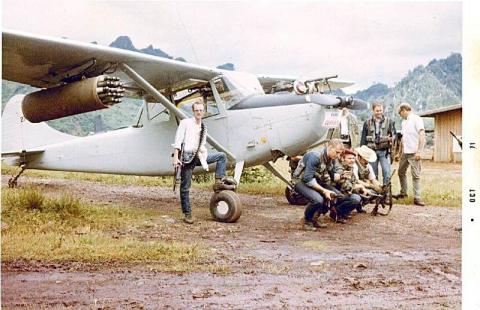Who Were the Ravens?

Ravens were Forward Tactical Air Controllers (FAC) that worked in conjunction with the Central Intelligence Agency (CIA) identifying targets in Laos during the Vietnam War.
Ravens were usually prior fighter pilots chosen to fly the Cessna O-1 Bird Dog, the standard plane of choice with all military markings removed. Pilots flew in civilian clothes and were also commanded to remove military gear and identification and were given appropriate civilian attire and identification.
In 1962, the United States and the Democratic Republic of Vietnam signed the Geneva Accords with a section stating that the Kingdom of Laos was to remain a neutral ground and called for the withdrawal of all foreign military presence in the region.
The United States withdrew their forces from the area. However, the North Vietnamese ignored the Accords as their main supply chain, the Ho Chi Minh Trail, ran through the country and they had no intent of giving it up. North Vietnam repeatedly stated they had no military presence in Laos despite having an estimated 4,000 or more troops stationed in the region.
The Lao government requested help from the United States to counteract the North Vietnamese. To avoid the appearance of also deliberately ignoring the Accords, President John F. Kennedy directed the United States Air Force to perform covert operations in Laos to assist in fighting North Vietnamese forces.
Ravens flew with Lao interpreters in the backseat as they marked enemy targets with smoke rockets, directed air strikes on those locations, and then observed and reported damage afterwards. The need for Raven teams to sight targets was to attempt to mitigate possible civilian casualties from the air strikes.
Individuals volunteering for the Ravens had no knowledge of the mission or of their destination. In order to qualify, a pilot was required to have at least four months combat duty, at least 60 days serving as a Forward Air Controller, at least 100 hours as a fighter pilot or FAC, 750 total flying hours, and at least 6 months remaining on their tour.
Due to flying a slow flying Cessna and generally at lower altitudes for proper target sighting, Ravens received significant resistance in terms of anti-aircraft fire. Their aircraft were known to have taken up to 50 hits in a single sortie. As a result, 90% of Ravens planes had been hit by ground fire during their tours of duty, 60% had been downed by enemy fire at some point, and 30% were killed in action.
Captain Richard W. Herold was a 1967 Rutgers graduate who joined the Air Force later that year. While conducting a mission as Raven 23, his aircraft went down, whether from enemy fire or collision with a jet fighter, on the 2nd of September in 1972. Due to enemy presence, no ground rescue was possible and no radio contact was able to be made with anyone who might have survived the crash.
Quotes regarding the Ravens
The best and the brightest, the craziest and the bravest Americans served in Laos, none braver than the men who flew in Combat as FACs known as Ravens…braving bad weather, tricky terrain, combat fatigue, poor maintenance, and occasional assassination teams to get the job done… (Asa Baber, Chicago Suns-Times, Nov 1987)
They went to war in blue jeans, T-shirts, and sometimes cowboy hats. It was a symbol of their disdain for the conventional, “bureaucratic” military. They were the Ravens, fighting a secret air war in the jungles of Laos, almost forgotten by everyone…(San Antonio Light, Oct 1987)
We heard about other pilots flying Cessna O-1s and North American T-28s out of places with exotic names like Luang Prabang, Xieng Khouang, Pakse, and Long Tieng. Fighter pilots are by nature independent and aggressive, and those mysterious bases had an allure for those who liked the idea of fighting a high-risk, no-bullshit war. (Ralph Wetterhahn, Air & Space Magazine, Nov 1998)
Air and Space Magazine Article: https://www.airspacemag.com/military-aviation/ravens-of-long-tieng-284722/